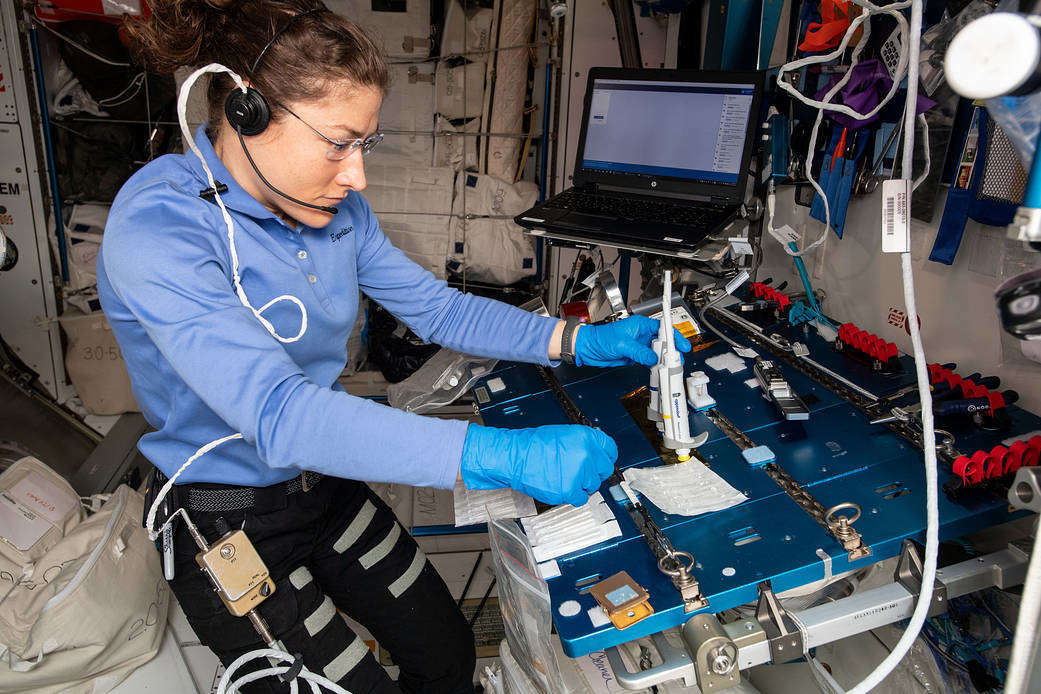Create a free profile to get unlimited access to exclusive videos, sweepstakes, and more!
CRISPR just proved genes can self-heal in space for the first time ever

If in space, no one can hear you scream, then what happens when DNA silently breaks in microgravity? Spoiler alert: it heals itself.
This is what a CRISPR experiment that won the Genes in Space 6 contest — SYFY WIRE was at the recent launch of the Genes in Space 8 experiment to the ISS — found out. DNA damage or breakage can mean the potential for degenerative diseases such as cancer, but the fact that it can also self-repair (and in microgravity!) has enormous implications for medical treatments above and below Earth’s atmosphere.
Genes in Space picks the brains of teen scientists in grades 7 through 12 to come up with a DNA analysis experiment that can be carried out in the ISS U.S. National Lab, which has really become more like a molecular laboratory in space. Aarthi Vijayakumar, Michelle Sung, Rebecca Li, and David Li were the winners who wanted to know if broken DNA could heal in zero-G.
Along with NASA microbiologists Sarah Rommel and Sarah Wallace, the students recently published a study in PLOS ONE.
“We have the capabilities to extract, amplify, purify, prepare sequencing libraries, and sequence nucleic acids onboard the ISS,” Wallace told SYFY WIRE. “While we have come a long way, there is still a lot that could advance the work further.”
You can’t just pack up an experiment and launch it to the ISS as is. Wallace and Rommel, in collaboration with biologist Emily Gleason of miniPCR and the Genes in Space Program, needed to create custom kits that took both the conditions in space and safety of the crew into account. Everything in those kits must undergo a tough toxicological assessment to make sure the astronauts are not being exposed to anything dangerous almost 250 miles from the ground. If something happens, astronauts can’t just wash their hands or roll the window down.
The ISS, as Wallace sees it, is a semi-closed system. Anything that is brought in from outside could possibly be a hazard, which is why scientists much make sure that whatever is on a payload will not endanger astronauts or mess with life support systems. Procedures also need to be streamlined. There is not that much crew time to go around, since the crew have multiple experiments to manage and also take care of other tasks, such as going on spacewalks to resolve maintenance issues. Everything in a kit needs to be packaged for one convenient use.
“The end result is a custom kit that has everything the astronauts need to perform the experiment we have planned,” said Wallace. “We use a lot of things from commercial kits, but we also use reagents we make in our labs, so it really is similar to what molecular labs on Earth are doing.”
There is a huge advantage to going through with the entire experiment in space rather than just breaking the DNA on Earth and sending it up to the ISS to see whether it can be repaired. Not everything used in a lab on terra firma can transition to microgravity. At least CRISPR (which is really an acronym for Clustered Regularly Insterspaced Short Palindromic Repeats) does. It replicates an immune response in which bacteria copy DNA sequences to RNA, which sends a protein to cut the DNA. CRISPR can break DNA in a specific place without random damage.
"It has been hypothesized that DNA is more likely to be repaired by the error prone method in microgravity than it is on Earth, but there hasn't been a good way to study this before now." Gleason also told SYFY WIRE. "The students wanted to know if DNA is repaired differently in microgravity and proposed using the CRISPR/Cas9 system to damage DNA so that we could study how it was repaired in space."
Astronauts created breaks in both strands of the double helix and waited to see what would happen. Our bodies do repair DNA on their own, but would these genes, taken from yeast, be salvageable in space? Replicating these processes in space was previously prevented by technical and safety risks that have now been worked out. After the DNA had repaired itself, it was sequenced to make sure that all its components had gone back to where they belonged. The methods used on the ISS aren’t limited to space, something Wallace is excited about.
“I believe that there is massive potential for this type of portable method in the diagnostic space,” she said. “There are many potential applications of these methods and technology, ranging from environmental monitoring, pathogen identification, revealing antimicrobial resistance, and so much more.”
Wallace and her team are currently working on a collaboration that will optimize an ISS method to see what kinds of microbes are crawling around in hospital rooms, since antibiotic resistance is an issue that (especially in this pandemic era) threatens healthcare. The miniPCR tech that is being used on the ISS has already been used in COVID-19 diagnostics, and Gleason also looks forward to updates that will be made to the ISS lab and Genes in Space.
"There's so much that can be done with the tools and procedures already on the ISS," she said. "Genes in space has plans to add flurorescence visulaization and cell-free protein synthesis technology next year."
This goes to show that studies done in microgravity this can go from Earth to space and back again.


























